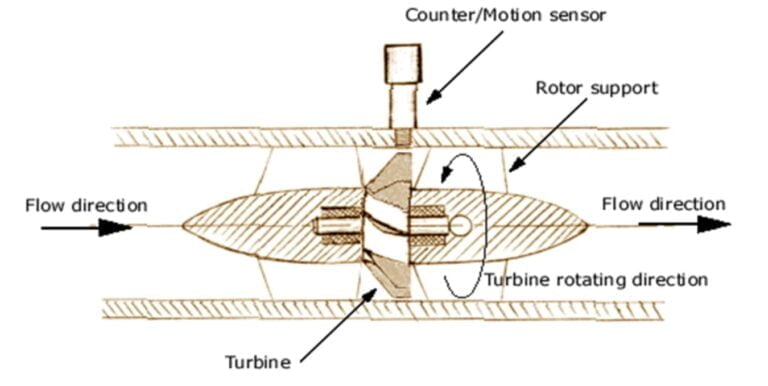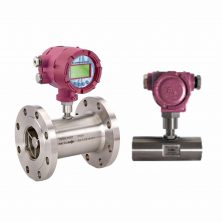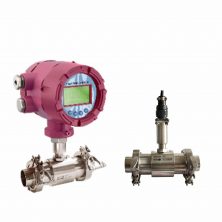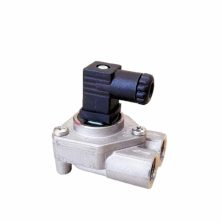Featured Products
Turbine Meter Overview
Turbine meters were introduced for liquid flow measurement by Reinard Woltman, an 18th century German inventor. Today many domestic water meters are called Woltman meters with a worldwide install base that perhaps numbers in millions of meters. Turbine meters may be used both in liquid and compressed gas applications. The turbine meter is comprised of a number of components that include the flow body, the rotating turbine element, the rotor support/axle, the bearing(s), and a pickoff module to count the turbine’s rotation. The key component that provides the flow rate reading is the rotating turbine element which consists of a multi-bladed rotor mounted at right angles to the flow in a pipe with free-spinning bearings. The rotors are slightly smaller than the flow tube and their speed of rotation is directly proportional to the volumetric flow rate of the fluid. The rotation of the blades can be detected by solid state devices (reluctance, inductance, capacitive and Hall-effect pickoffs) or by mechanical sensors (gear or magnetic drives).

Reluctance Pickoffs
A reluctance-type pickoff module consists of a permanent magnet, a ferrous metal pole piece and a wire coil. Each time a turbine blade passes through the field created by the magnet, the coil generates a pulse. Each pulse represents a discrete volume of the fluid; the number of pulses per unit volume is referred to as the meter’s K-factor.
Inductance pickoffs also come with a permanent magnet embedded in the rotor, as each blade passes the coil, it generates a voltage pulse representing one complete revolution of the rotor. The outputs of both pickoff styles are continuous sine waves with the frequency being proportional to the maximum flow rates. Since the pulse signal at low flow rates is very weak, the distance between the pickoff and associated display electronics or preamplifier must be short. Learn more About Handheld Ultrasonic Flow Meters here.
Capacitive Sensors
Capacitive sensors produce a sine wave by generating an RF signal that is amplitude-modulated by the movement of the rotor blades.
Hall-Effect Transistors
Hall-effect transistors change their state when they are in the presence of a very low strength (on the order of 25 gauss) magnetic field. Very small magnets are embedded in the tips of the rotor blades. In this type of system, the rotors are typically made of a non-magnetic material, like polypropylene, Ryton, or PVDF (Kynar). Their signal output is a square wave pulse train, at a frequency proportional to the volumetric flow rate.
Having no magnetic drag, the Hall Effect can operate at lower flow velocities (0.2 ft/sec) than magnetic pickoff designs (0.5-1.0 ft/sec). The Hall-effect sensor also provides a signal of high amplitude (typically a 10.8-V square wave), permitting transmission distances of up to 3,000 feet between the sensor and the electronics without amplification.
Turbine Meter Calibration
A typical turbine meter calibration curve illustrates the relationship between fluid flow and the K-factor (pulses/gallon). Turbine meters can be highly accurate; between 0.5-1% with some as high as 0.1% of reading (actual flow) and linearity of ±0.25% over a 10:1 wide flow range or ±0.15% linearity over a 6:1 range. The repeatability is typically from ±0.2% to ±0.02% over the linear range.
After they are calibrated, all turbine flowmeters are provided to the end user with a K-factor in pulses per unit volume within the manufacturer’s rated accuracy band. For better flow meter accuracy, several K-factors may be provided for different portions of the meter’s flow ranges. More importantly, the K-factor is applicable only to the fluid for which the meter was calibrated.
Smart Measurement’s ALTM turbine flow meter comes in sizes ranging from ½” to 12” (15-300 mm) and features a wide turn-down ratio with minimum uncertainty and a very repeatable output. The ALTM is excellent for precise measurement of instantaneous flows of low-viscosity fluids such as tap and demineralized water, fuels, liquefied gasses, light fuel oils, solvents, and pharmaceutical fluids.



